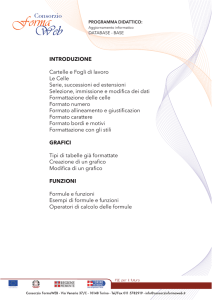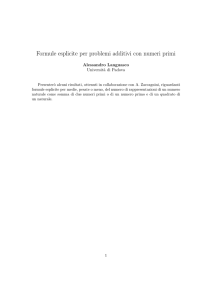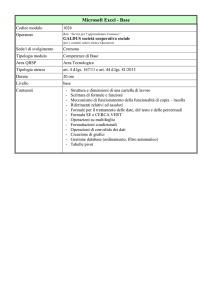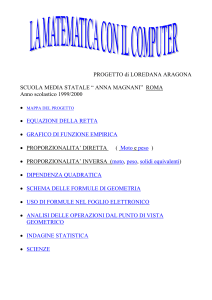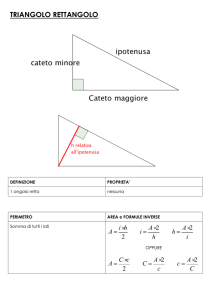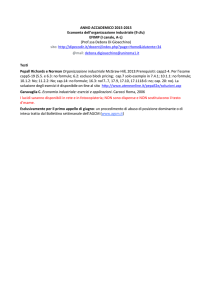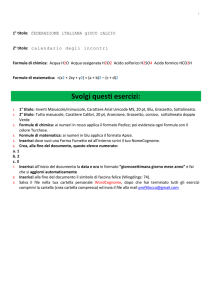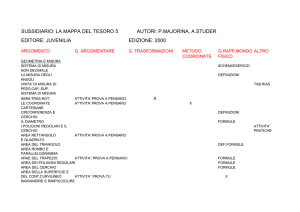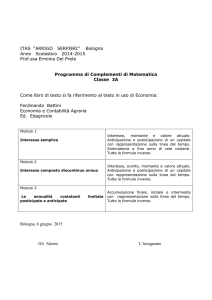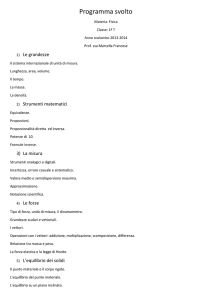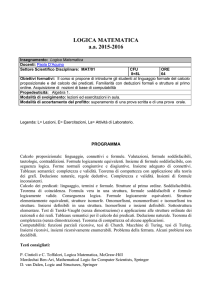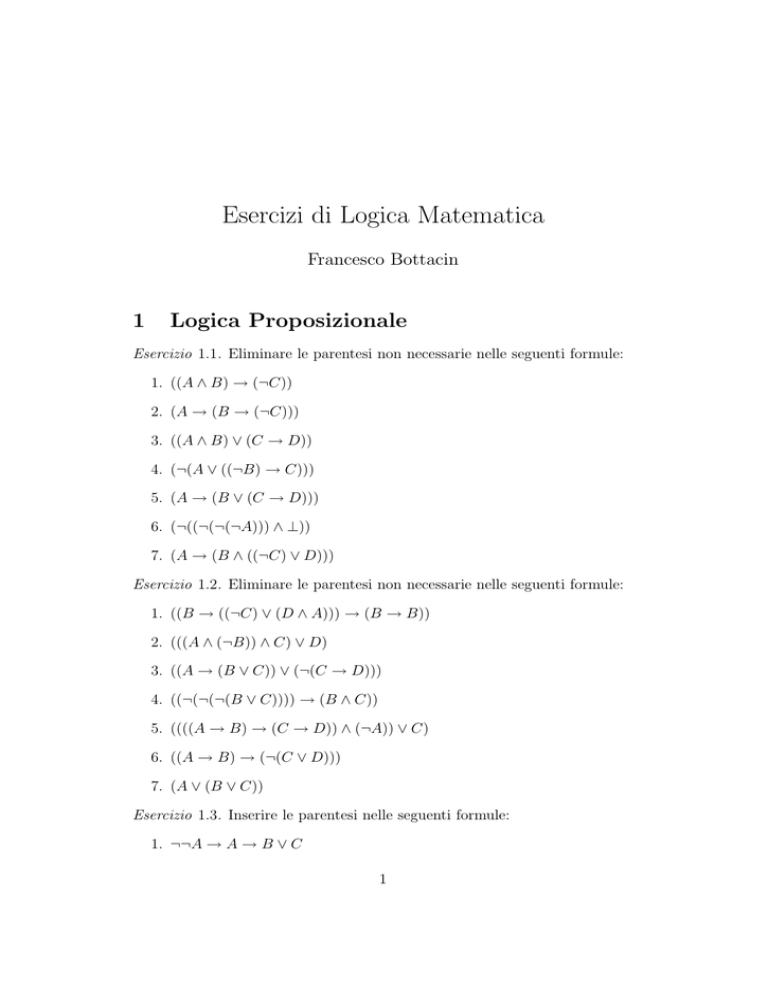
Esercizi di Logica Matematica
Francesco Bottacin
1
Logica Proposizionale
Esercizio 1.1. Eliminare le parentesi non necessarie nelle seguenti formule:
1. ((A ∧ B) → (¬C))
2. (A → (B → (¬C)))
3. ((A ∧ B) ∨ (C → D))
4. (¬(A ∨ ((¬B) → C)))
5. (A → (B ∨ (C → D)))
6. (¬((¬(¬(¬A))) ∧ ⊥))
7. (A → (B ∧ ((¬C) ∨ D)))
Esercizio 1.2. Eliminare le parentesi non necessarie nelle seguenti formule:
1. ((B → ((¬C) ∨ (D ∧ A))) → (B → B))
2. (((A ∧ (¬B)) ∧ C) ∨ D)
3. ((A → (B ∨ C)) ∨ (¬(C → D)))
4. ((¬(¬(¬(B ∨ C)))) → (B ∧ C))
5. ((((A → B) → (C → D)) ∧ (¬A)) ∨ C)
6. ((A → B) → (¬(C ∨ D)))
7. (A ∨ (B ∨ C))
Esercizio 1.3. Inserire le parentesi nelle seguenti formule:
1. ¬¬A → A → B ∨ C
1
2. ¬(¬A → A) → B ∨ C
3. A → (¬A ∨ B) → (A ∧ (B ∨ C))
4. ¬A ∨ B ∨ C ∧ D → A ∧ ¬A
5. ¬(A → B) ∨ C ∨ D → B
Esercizio 1.4. Scrivere la tavola di verità delle seguenti formule:
1. (A → B) ∧ A
2. (A ∨ ¬C) ↔ B
3. (A → B) ∧ (¬B ∨ A)
4. ¬(A → ¬B) ∨ (¬A ↔ B)
5. (A ∧ B ∨ ¬C) → ¬(B ∨ C)
Esercizio 1.5. Verificare quali delle seguenti formule sono delle tautologie:
1. (A → (B → C)) → ((A → B) → (A → C))
2. ¬(A → ¬A)
3. A ∨ ¬A
4. ⊥ → A
5. ¬A → (A → B)
6. (A ∧ B) ∧ (¬B ∨ C)
7. A ∨ B → A ∧ B
8. (A → C) → ((B → C) → (A ∨ B → C))
9. (A → B) → ((B → ¬C) → ¬A)
Esercizio 1.6. Verificare quali delle seguenti formule sono delle tautologie:
1. ((A → B) → B) → B
2. (A ↔ B) ↔ (A ↔ (B ↔ A))
3. A → (B → (B → A))
4. (A ∧ B) → (A ∨ C)
2
5. (A ∨ (¬(B ∧ C))) → ((A ↔ C) ∨ B)
6. ((B → C) → (A → B)) → (A → B)
Esercizio 1.7. Per ciascuna delle seguenti formule si determini se essa è una
tautologia, una contraddizione o nessuna delle due cose:
1. A ↔ (A ∨ A)
2. (A → B) → ((B → C) → (A → C))
3. ((A → B) ∧ B) → A
4. ¬A → (A ∧ B)
5. A ∧ (¬(A ∨ B))
6. (A → B) ↔ (¬A ∨ B)
7. (A → B) ↔ ¬(A ∧ ¬B)
Esercizio 1.8. Si stabilisca se il seguente insieme di formule è soddisfacibile:
{A ∨ B, ¬B ∨ ¬C, C ∨ D, ¬D ∨ E}
Esercizio 1.9. Si dimostri che la formula B ∨ C è soddisfacibile se e solo se
lo è la formula (B ∨ A) ∧ (C ∨ ¬A).
Esercizio 1.10. Sia il connettivo definito dalla seguente tavola di verità:
AB
1
1
0
0
A B
0 0
0 1
1 0
1 1
Lo si esprima in funzione dei connettivi ∨ e ¬.
Esercizio 1.11. Si scriva una formula P , contenente solo i connettivi ¬, ∧ e
∨, che abbia la seguente tavola di verità:
A B
0 0
0 0
0 1
0 1
1 0
1 0
1 1
1 1
C
0
1
0
1
0
1
0
1
3
P
1
0
0
0
0
0
1
1
Esercizio 1.12. Trovare delle forme normali congiuntive e disgiuntive equivalenti alle seguenti formule:
1. (A → B) → (B → ¬C)
2. ¬(A → (B → ¬C)) ∧ D
3. ¬(A ∧ B ∧ (C → D))
4. ¬(A ↔ B)
Esercizio 1.13. Per ciascuna delle seguenti formule si scriva una formula
equivalente in forma normale congiuntiva e una in forma normale disgiuntiva:
1. ¬(A → B) ∨ (¬A ∧ C)
2. A ↔ ((B ∧ ¬A) ∨ C)
3. ¬(A → B) ∧ ¬(C ∨ ¬D)
4. (A ∧ B) → ¬(A → ¬B)
5. A ∧ ¬B ∨ C → ¬A ∨ B ∧ ¬C
2
Logica dei Predicati
Esercizio 2.1. Determinare le variabili libere nelle seguenti formule:
1. ∀x ∃y A(x, y) → B(x, y)
2. ∃x, ∃y (A(x, y) → B(x, y))
3. ¬∀y ∃x A(y) → (B(x, y) ∧ ∀z C(x, z))
4. ∃x ∃y (A(x, y) → B(x)) → ∀z C(z) ∨ D(z)
Esercizio 2.2. Data la formula ben formata
Q = ∃x ∀y P (y, f (x), g(z)),
definire un’interpretazione che è un modello per Q ed un’interpretazione che
non lo è.
Esercizio 2.3. Si considerino le seguenti formule:
1. ∀x P (x, x)
4
2. ∀x ∀y (P (x, y) → P (y, x))
3. ∀x ∀y ∀z (P (x, y) ∧ P (y, z) → P (x, z))
Si dimostri che nessuna di tali formule è conseguenza semantica delle altre
due. (Suggerimento: trovare delle interpretazioni che sono dei modelli per
due delle formule date ma non per la terza).
Esercizio 2.4. Si stabilisca quali delle seguenti formule sono valide.
1. ∃x A(x) → ∀x A(x)
2. ∀x A(x) → ∃x A(x)
3. ∀x ∃y A(x, y) → ∃x ∀y A(x, y)
4. ∃x ∀y A(x, y) → ∀x ∃y A(x, y)
Esercizio 2.5. Stabilire quali delle seguenti formule sono valide e quali sono
solo soddisfacibili. Nel secondo caso, fornire un esempio di interpretazione
che non ne è un modello.
1. (∃x A(x) → ∀x B(x)) → ∀x (A(x) → B(x))
2. (∃x A(x) → ∃x B(x)) → ∀x (A(x) → B(x))
3. (∃x A(x) → ∃x B(x)) → ∃x (A(x) → B(x))
4. ∃x (A(x) → B(x)) → (∀x A(x) → ∀x B(x))
5. ∃x (A(x) → B(x)) → (∀x A(x) → ∃x B(x))
6. ∃x (A(x) → B(x)) → (∃x A(x) → ∃x B(x))
7. ∀x (A(x) → B(x)) → (∃x A(x) → ∀x B(x))
8. ∀x (A(x) → B(x)) → (∃x A(x) → ∃x B(x))
9. ∀x (A(x) → B(x)) → (∀x A(x) → ∀x B(x))
10. (∀x A(x) → ∀x B(x)) → ∀x (A(x) → B(x))
11. (∀x A(x) → ∃x B(x)) → ∃x (A(x) → B(x))
12. (∀x A(x) → ∃x B(x)) → ∀x (A(x) → B(x))
Esercizio 2.6. Dimostrare che le seguenti formule non sono valide.
5
1. (∀x A(x) → ∀x B(x)) → (∀x (A(x) → B(x)))
2. (∀x (A(x) ∨ B(x))) → ((∀x A(x)) ∨ (∀x B(x)))
Esercizio 2.7. Trovare una forma normale prenessa equivalente alle seguenti
formule:
1. (∀x (A(x) → B(x, y))) → ((∃y A(y)) → (∃z B(y, z)))
2. ∃x A(x, y) → (B(x) → ¬∃y A(x, y))
6


